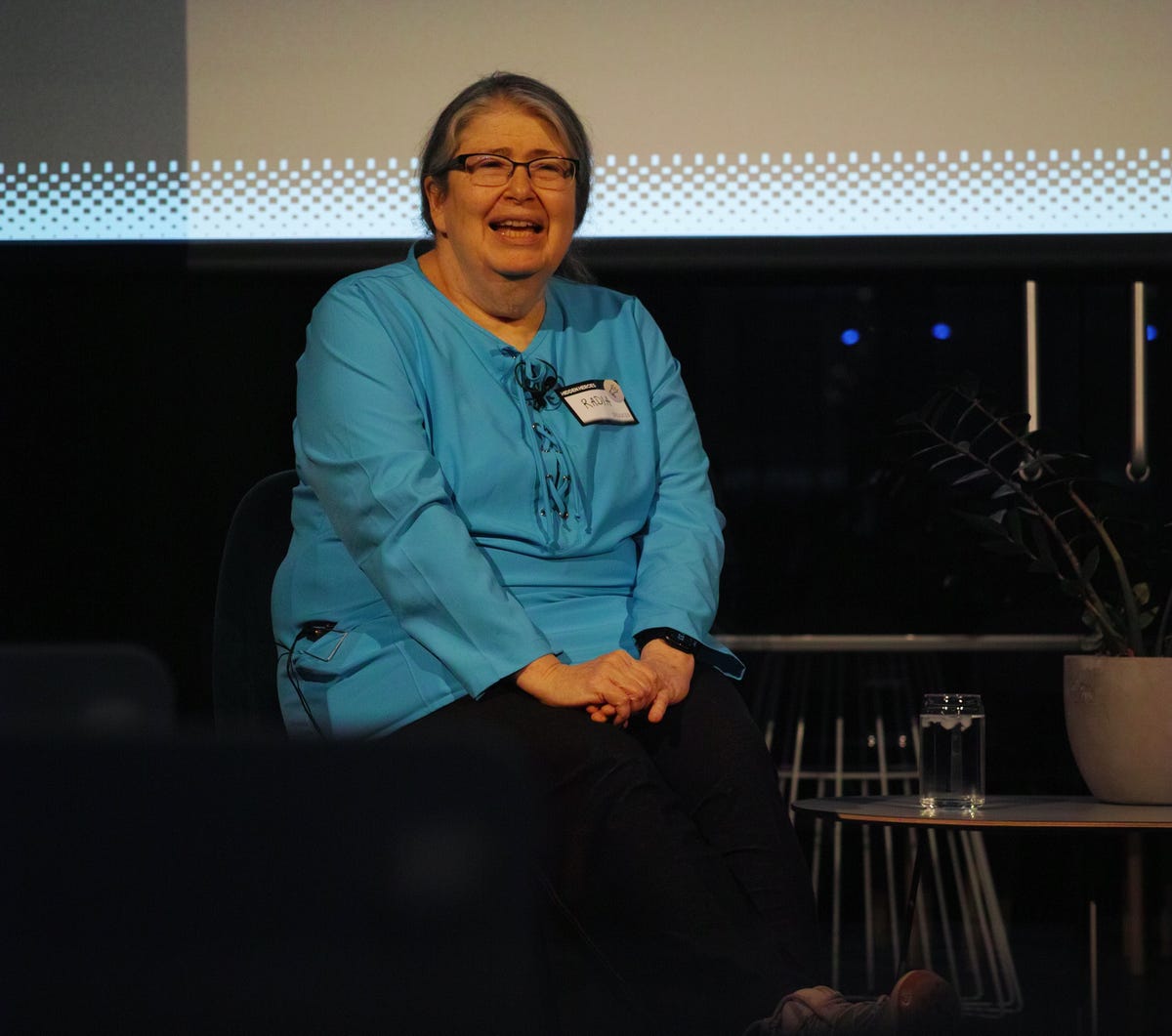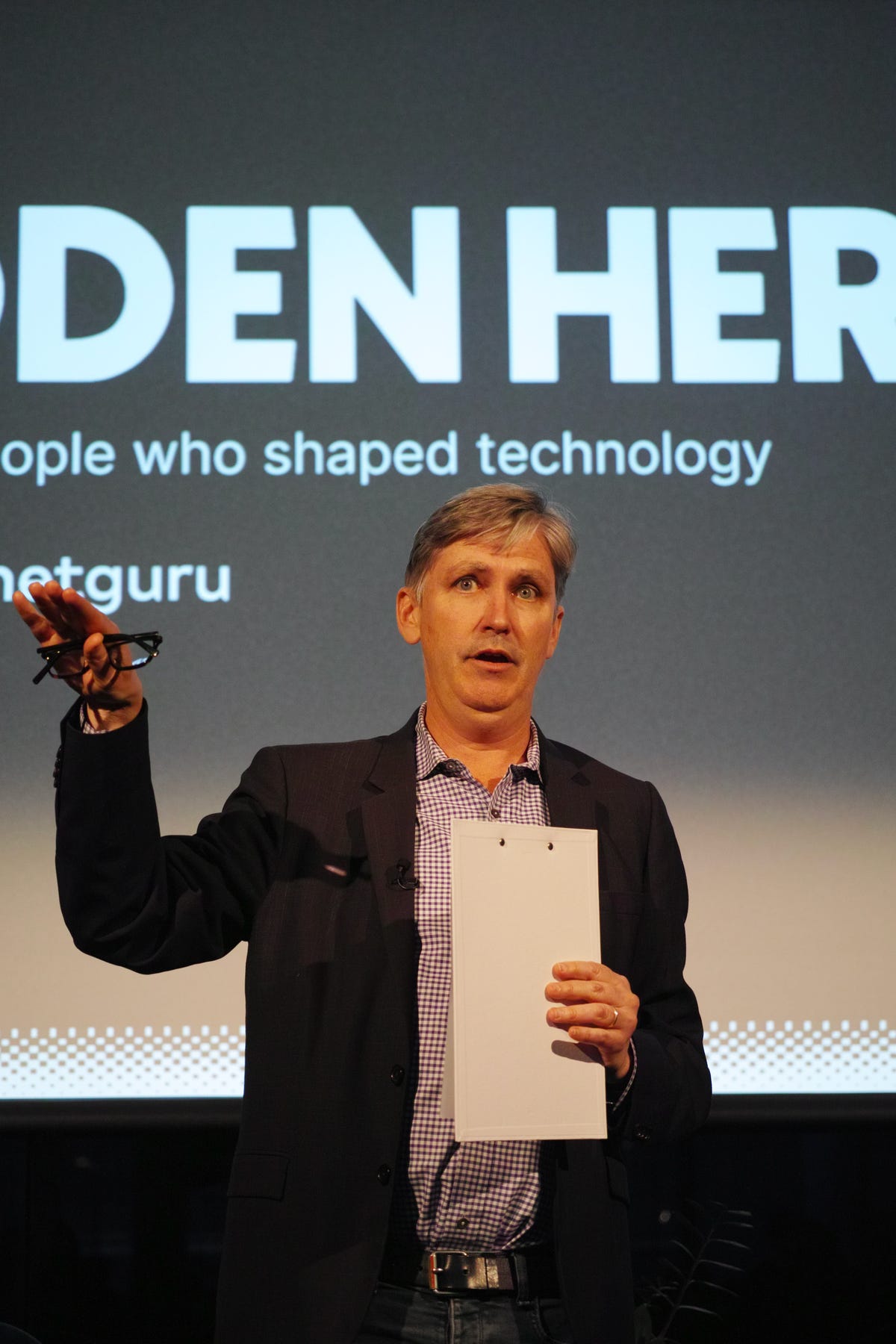The computer network on which you’re working and playing in some sense functions because Radia Perlman figured out in an afternoon how to prevent computer network disasters.
Nearly forty years ago, Perlman’s boss at Digital Equipment Corporation, then a titan of the computer world, challenged her to divine a way that computer networks could scale across multiple network segments spanning offices, cities, and regions.
“He asked me on a Friday, and right before he was going away on vacation for a week, so he would be unavailable, just to make it extra challenging,” recalled Perlman with a chuckle.
Undaunted, Perlman hit upon a solution later the same day. “I realized that night, Oh, my god, it’s trivial,” said Perlman, who has a disarming way of turning complex achievements into no big deal. “Yeah, you just think about it the right way, I knew just how to do it.”
By Tuesday, Perlman had finished writing up the technical details of the spec for what would come to be known as spanning tree protocol, or STP, a key “layer two” technology for local area networks.
“I spent the remainder of the week working on the poem that goes along with it,” she recalled.

Computer science classes “drove me crazy,” said Perlman. “Mathematical thinking is always very clear.”
Tiernan Ray for ZDNetThe ode to spanning tree that Perlman put on the front page of her spec, “Algorhyme,” deftly reconstitutes Joyce Kilmer’s “Trees” in exact meter:
I think that I shall never see
A graph more lovely than a tree.
A tree whose crucial property
Is loop-free connectivity.
A tree which must be sure to span
So packets can reach every LAN.
First the Root must be selected.
By ID it is elected.
Least cost paths from Root are traced.
In the tree these paths are placed.
A mesh is made by folks like me
Then bridges find a spanning tree.
Perlman recited the poem by heart to a group of reporters and admirers Thursday night in New York’s Meat Packing District, where she was honored as the subject of a multi-part series, “Hidden Heroes,” exploring the unsung innovators of computer technology.
The series, published by the software development consultancy Netguru, is being compiled this year by noted technology reporter Steven Johnson, author of books such as Extra Life: A short history of Living Longer, and, How We Got To Now. Johnson interviewed Perlman onstage.
Johnson paid special thanks to the staff of Netguru, many of whom came to New York City this week from the company’s headquarters in Poznań, Poland for the first time.
Netguru’s CEO, Marek Talarczyk, thanked the hidden heroes back home, those who are contending with the effects of Russia’s war in Ukraine, including helping over two million Ukrainian refugees who have entered Poland.
Talarczyk explained the inspiration for Hidden Heroes as giving credit where due. He related his own experience growing up enchanted by technologies that made the Internet possible and appeared to function like magic.
“We honor business leaders such as Elon Musk, but we don’t always pay attention to those who started those technologies,” said Talarczyk.

“Because innovation has generated such vast fortunes, when we think about world-changing ideas our attention is drawn to the shiny objects of wealthy people,” says technology writer Steven Johnson.
Tiernan Ray for ZDNet“It’s high time we pay tribute to those software pioneers.”
Johnson echoed the sentiment, saying, “because innovation has generated such vast fortunes, when we think about world-changing ideas our attention is drawn to the shiny objects of wealthy people.”
“Sometimes innovation happens at a lower level,” said Johnson, a realm of almost invisible technology that “just works,” such as networking protocols underlying the Internet.
“We want to make those invisible breakthroughs visible, that’s the ambition.”
Perlman, who studied under AI pioneer Seymour Papert at MIT, first earning an undergraduate degree, and later, a PhD, is an unlikely computer science hero. “You hear about these engineers who grow up taking things apart, but I was never like that,” Perlman told the audience. “I never took anything apart because I was afraid I would break it.”
“But I was always the best in math and science,” she recalled. Perlman’s strategy early on was to take on the hardest science problems, starting with physics. “I got as far as quantum mechanics, and then I was out of there,” switching to mathematics, and only later to computer science. “That’s the usual path people take, physics, math, computer science, and then humanities.”
Perlman had “no idea what I wanted to do, I was interested, kind-of, in anything,” she said, but, initially, “as long as it didn’t involve computers!”

“We honor business leaders such as Elon Musk, but we don’t always pay attention to those who started those technologies,” said Netguru CEO Marek Talarczyk.
Tiernan Ray for ZDNetMathematics thinking was “clear,” she said, computer science classes never made any sense. “They would drive me crazy,” she recalled. “A professor would wax rhapsodic about object-oriented programming, and I didn’t understand, and then at some point, I’d realize, Oh! You’re just saying the program should have a library!”
Perlman was drafted into programming by a teaching assistant at MIT who was eager to help a young person learn the art given that an unskilled draftee would be cheaper to employ for programming tasks than a trained programmer. She was one of only a handful of women in the MIT dorms in an era of a one-to-fifteen gender ratio.
“The school was full of these incredibly shy, awkward, sensitive boys who had never talked to a girl before,” recalled Perlman. “You would just say hello, and they would get all excited — a girl talked to me! — and think they were going to get married — I felt so incredibly bad about that!”
As a reluctant computer programmer, Perlman nevertheless found she had an ability to cut through the complexity to foundational solutions to computer science problems.
“My superpower is that I have no memory,” she explained. “I have to understand things so deeply that I can figure them out from a couple of concepts, and I get rid of all irrelevant details.” Most programmers, she observed, would do something like the opposite, they’d just start coding, working out details first.
Perlman, who wrote one of the foundational textbooks that is required reading in networking, observes the discipline with dry wit. At Digital Equipment, the networking technology she helped create, DECNet, was deemed “boring” by customers.
“I said, I’ll put knobs on it to make it more exciting, and if you touch them, nothing bad happens because all the knobs have the same setting!”
Her impulse, she said, was always to simplify. “I hate gadgets,” said Perlman. “I want to design things for people like me; I wanted you to be able to just plug it together and it works.” In many of the emerging settings for technology among DEC’s customers, she noted, ordinary people had to be able to depend on the network. “When you have a network in a hospital, doctors shouldn’t have to be network people,” she said.
“I’m proud of making networks much more self-configuring so you don’t have to worry about them.”
Her crowning achievement, the spanning tree protocol, was an exercise in elegance, a distillation of the problem down to a single, eidetic concept.
The problem was that early computer networks consisted of individual machines with no knowledge of how they were all connected to one another. To pass a message from one machine to another, all the machines in between the two would forward on the message. Sometimes, because they didn’t know much, a computer along the way would mistakenly re-direct the message back to its originator, not knowing it was the originator. That could happen repeatedly, resulting in a never-ending loop of data transmission that could bring down the network.

A spanning tree is a form that takes shape inside a mesh, touching each vertex of the mesh only once.
David EppsteinTo end the loops, Perlman came up with a recipe for a few computers along the way to have more knowledge about the total structure of the network. They could forward the message to certain computers that were best placed not to send the message back to its originator. The smarter software in practice made the network a structure with no loops, just a tree shape, a branching form leading ever outward. In mathematics, a single path that connects all the points in space of a grid once and only once is called a spanning tree, hence, the name.
The software rules written by the programmer set up grid, but it is the software operating on its own, in real time, that then divines the smart path within that grid.
Hence, Perlman’s final stanza of her poem, recapitulating the spirit of Kilmer’s final stanza:
A mesh is made by folks like me
Then bridges find a spanning tree.Poems are made by fools like me,
But only God can make a tree.
Part and parcel of piercing the heart of the matter technically for Perlman is being a realist about the evolution of computer technology. Many times, the best approaches to a problem don’t win out, she observes.
“Spanning tree was not ideal by any means,” she told ZDNet following the interview. And neither was the Internet Protocol technology that became the heart of the internet, she argues. Much better was a computing standard called Connectionless-mode Network Protocol, or, CLNP, which she was championing in the early 1990s, but which lost out to IP version 6.
The two technologies were promoted by competing technology standards organizations, and that made all the difference, she explained.
“A lot of the time, we like to think that standards bodies are composed of very smart people who are thinking about the best approach to deep technical problems,” Perlman told ZDNet. “In fact, they’re a lot more like drunken sports fans!”
























